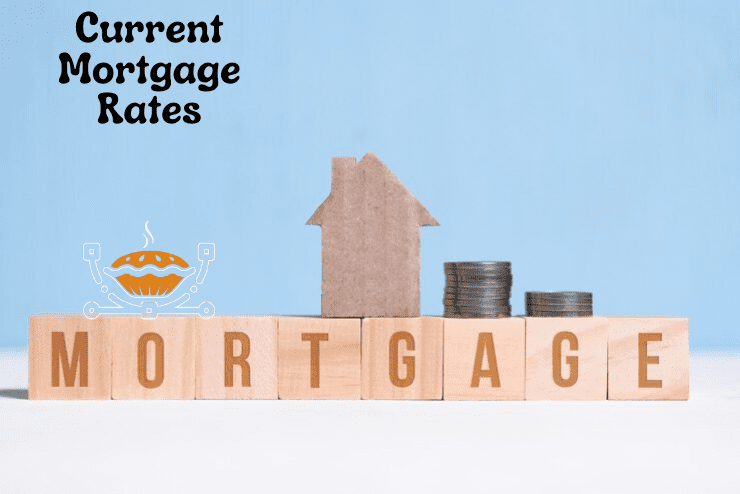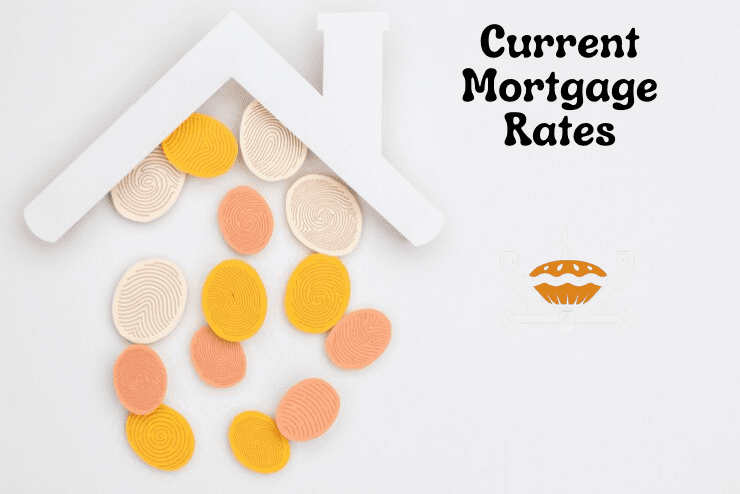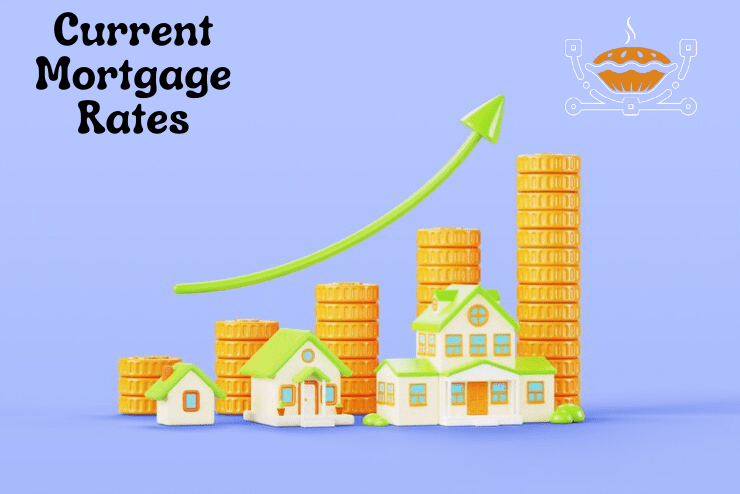Not many things in the world of homeownership are as important as Current Mortgage Rates. Knowing how these rates work and how they affect your financial situation is critical whether you’re a first-time buyer or an experienced homeowner wishing to refinance.
As of May 2024, here are the current mortgage rates in the United States:
- 30-Year Fixed Rate: 7.34% with an APR of 7.39%
- 20-Year Fixed Rate: 7.16% with an APR of 7.21%
- 15-Year Fixed Rate: 6.74% with an APR of 6.82%
- 10-Year Fixed Rate: 6.74% with an APR of 6.81%
- 5-1 ARM: 6.74% with an APR of 7.99%
- 10-1 ARM: 7.40% with an APR of 8.11%
- 30-Year Fixed Rate FHA: 7.19% with an APR of 7.24%
- 30-Year Fixed Rate VA: 7.28% with an APR of 7.32%
- 30-Year Fixed Rate Jumbo: 7.41% with an APR of 7.47%
Note that a number of variables, Current Mortgage Rates and the state of the economy, can cause mortgage rates to change. Seeking the best rate for your particular circumstances, you should speak with a financial counselor or mortgage specialist if you are thinking about getting a mortgage. Remember that these prices are dynamic, thus it’s a smart idea to be aware of any changes or market developments.

What factors affect mortgage rates?
Mortgage rates are affected by a number of variables, which lenders consider when deciding what interest rate to provide to borrowers. Here are several important elements:
Economic Conditions: A big part is played by the general state of the economy. The demand for loans during a robust economy typically drives up mortgage rates. On the other hand, rates might drop in recessionary times to encourage borrowing and expenditure..
Federal Reserve Policies: By use of its monetary policy, the Federal Reserve, the US central bank, affects short-term interest rates. Higher mortgage rates can result from the Fed raising its federal funds rate, which is its benchmark interest rate. Lower mortgage rates can, however, follow Fed rate reductions.
Inflation: Over time, inflation reduces the value of money as a purchase. Current Mortgage Rates rates to reflect inflation. Mortgage rates usually climb along with inflation forecasts.
Credit Score: Higher credit-score borrowers are often eligible for lower interest rates. Excellent credit borrowers are seen as less hazardous by lenders, who therefore extend better conditions.
Loan Term: Generally speaking, shorter loan durations—15 years, for example—have lower interest rates than longer terms (30 years, for instance). This is so because shorter payback terms entail less risk for lenders.
Loan-to-Value Ratio (LTV): LTV shows what much of the house’s worth the borrower is financing. Better rates are sometimes found with a smaller LTV (bigger down payment).
Type of Loan: Interest rates on various loan types—conventional, FHA, VA, etc.—vary. Government guarantees may mean that FHA and VA loans have more competitive rates.
Market Demand: Dynamics of supply and demand in the housing market impact mortgage rates. Rates may go up in a strong demand for houses.
Geographic Location State and location-specific rates may differ. A part is played by local market conditions, housing demand, and cost of living.
Lender Policies: Every lender sets its own rates according on risk tolerance, business plan, and internal policies. Borrowers that shop around for lenders often get the greatest deal.
Recall that these elements interact and that situations differ from person to person. Current Mortgage Rates at all of their possibilities, compare rates, and take their financial status into account when selecting a mortgage. If you intend to purchase a house, speaking with a mortgage expert might offer tailored advice depending on your requirements.
What are the pros and cons of adjustable-rate mortgages?
Mortgages with adjustable rates (ARMs) offer benefits as well as drawbacks. Let’s look at them.
Pros of Adjustable-Rate Mortgages (ARMs):
- Lower Initial Payments: ARMs frequently begin with a lower initial interest rate, also referred to as the “teaser” rate, than do fixed-rate mortgages. This suggests that you can afford your initial monthly payments.
- Flexibility: An ARM can offer flexibility if you know you’ll only hold the loan for a few years (e.g., because of a move or other life event). Profit from the fixed-rate term and sell the house before the adjustable phase starts.
- Rate and Payment Caps: The mortgage rate and your payment can only increase so much with an ARM. These restrictions shield some from sharp increases in rates.
Cons of Adjustable-Rate Mortgages:
- Complexity:More complicated than fixed-rate mortgages are ARMs. The way rate modifications function, the index used, and the frequency of adjustments must be understood by borrowers.
- Risk of Payment Spikes:Should interest rates increase once the adjustable period starts, your payments may increase considerably. For some borrowers, this unpredictable nature can be a negative.
- Difficulty Qualifying for Future Loans:Because future payments are unpredictable with an ARM, qualifying could be more difficult if you choose one and then decide to refinance or take out another loan.
All things considered, short-term homeowners who value flexibility and early affordability may find ARMs beneficial. Still, carefully weigh the advantages and disadvantages according to your financial objectives and personal circumstances. Making an educated choice needs speaking with a mortgage expert.
How do I choose between a fixed-rate and an ARM?
Your choice of a fixed-rate or Current Mortgage Rates will depend on your financial objectives, risk tolerance, and personal circumstances. Examining the differences and considerations for every kind:
Fixed-Rate Mortgage:
- Interest Rate Stability:A fixed-rate mortgage’s interest rate remains constant over the term of the loan. Your interest and principle payments each month remain the same unless you want to refinance.
- Predictable PaymentsBecause you are aware of your exact payments, a fixed rate makes budgeting easier.
- Long-Term Stability:Fixed-rate mortgages work well if you value stability and want to stay in your home for a long time.
- Term Options: Fixed-rate mortgages come in flexible options ranging from eight to 29 years in addition to 30- and 15-year maturities.
- Property Taxes and Insurance:Recall that changes in homeowners insurance rates and property taxes may affect your entire payment, but changes in the loan principle and interest portion won’t.
Adjustable-Rate Mortgage (ARM):
- Initial Lower Rate:A conventional fixed-rate mortgage usually has a higher starting fixed interest rate than an ARM. Three, five, seven, or 10 years can pass between this first time.In ten years, perhaps.
- Rate Adjustments: After the introduction, the rate is adjusted, usually every six months or annually. The adjustment is linked to a financial or stock market index, such the Secured Overnight Financing Rate (SOFR).
- Risk and Flexibility:ARMs are riskier since they might increase in rate with time. They do, however, offer flexibility for those who want to sell their house fast or who think loan rates will drop.
- Lower Initial Payments:If you plan to sell the house before the adjusting phase begins, an ARM may allow you to make less initial payments.
- Complexity:Borrowers of ARMs need to understand how rate changes work because they are more intricate than fixed-rate mortgages.
Considerations:
- Time Horizon: Consider the length of time you plan to reside in the home. Should this be a long-term investment, a fixed rate could make more sense.
- Rate Expectations:Look up your interest rate forecast. If you believe rates will drop, an ARM could be interesting.
- Risk ToleranceCould you possibly put up with rate changes? More dangerous are ARMs.
- Financial Stability: Examine your ability to control changes in payments and your stability of finances.
- Consult a Professional: See a mortgage consultant to assess your unique situation and come to an informed choice.
Remember that every option offers benefits and drawbacks; base your choice on your personal needs and preferences.
What is the current trend in mortgage rates?
In the United States as of May 6, 2024, the average 30-year fixed mortgage interest rate is 7.34%, up 2 basis points from the prior week1. Mortgage rates can change for a variety of reasons, including the state of the economy, inflation, and Federal Reserve policy.
Current mortgage rates for various loan terms are broken down here:
- 30-Year Fixed Rate: 7.34% with an APR of 7.39%
- 20-Year Fixed Rate: 7.16% with an APR of 7.21%
- 15-Year Fixed Rate: 6.74% with an APR of 6.82%
- 10-Year Fixed Rate: 6.74% with an APR of 6.81%
- 5-1 ARM: 6.74% with an APR of 7.99%
- 10-1 ARM: 7.40% with an APR of 8.11%
- 30-Year Fixed Rate FHA: 7.19% with an APR of 7.24%
- 30-Year Fixed Rate VA: 7.28% with an APR of 7.32%
- 30-Year Fixed Rate Jumbo: 7.41% with an APR of 7.47%1
Remember that these rates are liable to vary depending on lender rules and the state of the market. If you’re thinking about getting a mortgage, you should speak with a mortgage expert or financial counselor to go over your choices and determine the best rate for your particular circumstances.
Understanding Mortgage Rates
A mortgage rate is fundamentally the interest that is assessed on a home loan, which establishes the borrowing cost. These rates change according to the state of the economy generally as well as inflation and employment rates. Your monthly mortgage payments’ interest component is determined by lenders using these rates.
Factors Influencing Rates
Many variables influence the mortgage rate environment, including but not limited to bond yields, lender market rivalry, and the monetary policies of the Federal Reserve. Furthermore important factors influencing the final rate offered are the credit scores, down payments, and borrower profiles of each individual.
Impact on Monthly Payments
Any little shift in mortgage rates can have a significant knock-on effect. A lower rate means lower monthly payments, which over the course of the loan might save thousands of dollars. Higher rates, on the other hand, can raise monthly payments, which would affect your budget and long-term financial objectives.
Fixed vs. Adjustable Rates
A lot of the time, borrowers struggle to choose between fixed-rate and adjustable-rate mortgages. Over the course of the loan, fixed rates provide stability and predictability; adjustable rates may begin lower but are susceptible to change depending on the state of the market.
Shopping for the Best Rates
Securing the best mortgage rates calls for thorough investigation and comparison shopping. Mortgage brokers and internet resources can help in the search for cheap rates suited to your financial situation and aspirations of homeownership.
Rate Locks and Float-Downs
Borrowers can have some defense against unexpected rate increases in a choppy market with rate locking and float-down alternatives. Learn the subtleties of these tactics, and borrowers can confidently negotiate market swings.
Mortgage Rate Trends
The course of mortgage rates can be greatly understood by examining past patterns and professional projections. Prospective homeowners might make strategic decisions based on past performance even though it is not a guarantee of future results.
Mortgage Rate Calculator
With a mortgage rate calculator, borrowers may project their monthly payments depending on current rates and loan circumstances. A useful tool for budgeting and determining affordability is this one.
Current Mortgage Rates
Lenders and comparison websites are the best sources for the most recent information on current mortgage rates. Borrowers who follow rates in real time can take advantage of good market circumstances and get the best financing possible.
Mortgage Rate Forecast
Though it is difficult to forecast mortgage rate changes with 100% accuracy, industry professionals provide priceless information on current economic trends and market indicators. Knowledge gives borrowers the ability to choose their home mortgage with initiative.

How to Get the Lowest Rates
Keeping up a great credit score, lowering your debt-to-income ratio, and looking around for the best loan terms are all important components of getting the lowest mortgage rates. Over the course of a mortgage, preparation and diligence can result in significant savings.
FAQs
What factors determine mortgage rates?
Individual borrower profiles as well as a number of economic variables including inflation, bond yields, and lender policies affect mortgage rates.
How often do mortgage rates change?
Mortgage rates can change every day or even every hour in reaction to economic and market factors.
Can I negotiate my mortgage rate?
Borrowers may have considerable negotiating room even if lenders base their rates on a number of variables, especially if they have solid credit and financial profiles.
What is a good mortgage rate?
The market environment and the particulars of each borrower determine what constitutes a “good” mortgage rate. Rates below the national average are usually seen to be advantageous.
Should I lock in my mortgage rate?
In a choppy market, rate locks give borrowers piece of mind by shielding them from possible rate rises during the loan processing time.
How can I improve my chances of qualifying for a low rate?
You may have better luck getting a cheap mortgage rate if you keep up a good credit score, pay off debt, and save a large down payment.
Conclusion
Understanding Current Mortgage Rates is critical in the often changing world of homeownership. Equipped with information and tactical understanding, you may confidently start the process of becoming a homeowner and get the finest financing available for your ideal home.
Also Must Read: MSW Degree Program: Master’s in Social Work
Must Read: Unlocking Success with CrowdStrike University Subscription
